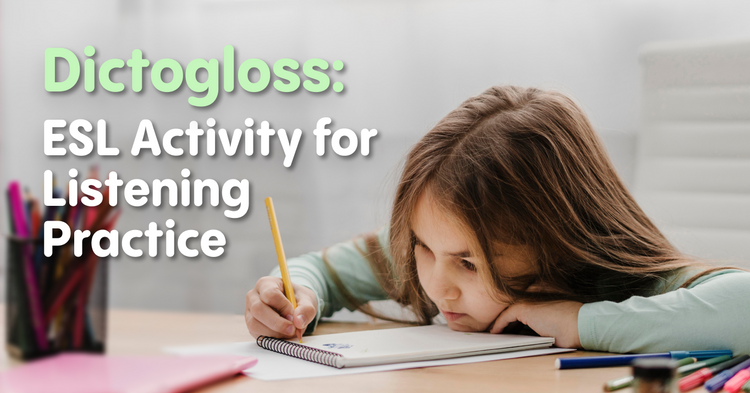English as a Second Language (ESL) learners often face challenges in developing their listening comprehension skills. One effective and engaging method to improve listening skills is through the dictogloss technique. Dictogloss combines listening and language production, encouraging learners to actively engage with the spoken language and enhance their understanding. In this article, we will explore how to practice listening using dictogloss in an ESL classroom.
Understanding Dictogloss
Dictogloss is a language learning activity that involves listening to a passage, taking notes, and then reconstructing the text.
It helps learners focus on understanding the overall meaning, grammatical structures, and vocabulary usage within the given context. The process of dictogloss typically consists of listening, note-taking, collaborative reconstruction, and analysis of the final output.
Step-by-Step Practice Guide
1. Selecting Suitable Texts
Choose texts that are appropriate for the proficiency level of your ESL learners. The content should be interesting and relevant to the learners' interests and knowledge. It's important to strike a balance between challenging and understandable, as the goal is to stretch their language capabilities without overwhelming them.
2. Introduce the Dictogloss Activity
Explain the dictogloss activity to the students. Emphasize that the objective is to understand the content, capture key points, and later reconstruct the passage accurately. Encourage active listening and stress the importance of collaboration and accuracy.
3. Listening and Note-Taking
Play the audio or read the passage aloud to the class. During the first listening, students should focus on grasping the main ideas and overall context.
In subsequent listenings, encourage them to take notes, jotting down key words, phrases, and any other information they consider relevant.
4. Collaborative Reconstruction
Divide the class into small groups. Each group will work together to reconstruct the passage using their collective notes. Encourage discussions and debates within the group to arrive at a cohesive reconstruction. This collaborative aspect fosters communication and critical thinking.
5. Comparison and Analysis
After the reconstruction phase, provide the original text to the students. Ask each group to compare their version with the original, noting any discrepancies. As a class, analyze the differences, focusing on vocabulary, grammar, and overall structure. This analysis helps students identify areas for improvement.
6. Follow-Up Activities
To reinforce learning, incorporate follow-up activities such as discussions, debates, writing assignments, or role-plays based on the reconstructed text. These activities provide students with additional practice and application of the language skills acquired through the dictogloss activity.
7. Regular Practice and Progress Tracking
Integrate dictogloss regularly into the ESL curriculum to ensure consistent practice. Track students' progress over time, monitoring their listening comprehension skills and language accuracy. Adjust the difficulty of the texts as their proficiency improves.
Dictogloss Listening and Speaking Activity
Skills: Speaking/listening
Age: 8+
Supplies needed: a short narrative, pens, and paper
Time: 10–20 minutes
For students at a more advanced level, dictogloss is a straightforward exercise that improves their listening and memory abilities, as well as their ability to substitute vocabulary terms when they can no longer access the original word. Our students would benefit from practicing this skill because they might run into it frequently in real life.
Where Can I Find This Story?
Pick a brief, captivating story to read or invent your own. From children's stories to a tale about something I did over the weekend, I've used a variety of materials. Almost everything can function. You can find stories in textbooks or create simple ones on your own. Or, locate a narrative in which someone discusses their experiences.
The next step - read the story to the students
Depending on the student's level, tell the narrative one to three times. Of course, you can adjust your speaking pace to make the task easy or harder. After you have finished telling the narrative, the students will need to retell it in groups of two to three. Stress that while they won't be able to exactly duplicate the narrative you told, they should make an effort to maintain the same intent.
Each team can compare results with another team. Retell the original tale afterward so that the kids can see their conclusions. This practice also functions nicely as a writing exercise.
Advice for Teaching Dictogloss
Make sure to place children in pairs or groups of three for this activity since it's really beneficial for them to compare answers with a partner before they have to speak in front of the class. The weaker pupils benefit from having a stronger student bring them up to speed. Also, it boosts students' self-assurance that they are on the right road and makes them feel less anxious about sharing their solutions with the class.
Although it should go without saying, adjust this activity to the students' abilities. Make it relatively simple for the pupils to complete if you're using it as a fast warm-up or introduction to basic grammar or vocabulary.
Dictogloss Activity Procedure
- Prepare a short story that you’ll read to your students. It is preferable to read a short text as compared to a lengthy, complex story.
- Put students in groups of two or three and the teacher reads the story to them. Read at normal speed in most cases. Part of the challenge for the students is recreating the story when they didn’t understand all the things they heard.
- You can encourage students to take short notes about what they heard. Not full sentences, just a few words.
- Students try to remember the details of the story, reconstruct it as best they can, and then compare it with their group. I usually only allow them to do this by speaking. But, you could do it with writing as well.
- Students should listen while you read the story a second time before attempting to speak the story more precisely. Provide assistance now if necessary (a form or some terms perhaps).
- Read the story again (depending on the level and difficulty of the story) and the students again attempt to recreate it, even more closely.
- Ask a few teams to share their experiences with the class (in a small class). Alternately, combine two teams so that they can share stories with one another (in a larger class). Use this as a tool for informal assessment to determine how well your pupils are mastering this skill and, if possible, identify their areas for improvement (if they did). As an illustration, difficulties with listening, vocabulary, grammar, etc.
- Read the story one final time for students to compare with their own.
Incorporating the dictogloss technique into ESL classrooms can significantly contribute to the development of listening skills among learners. By providing an interactive and engaging way to practice listening and language production, dictogloss empowers ESL students to comprehend and communicate in English more effectively.









